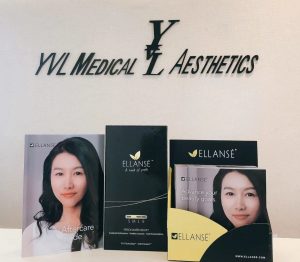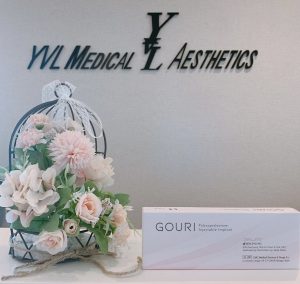
Biostimulators are a heterogenous class of medical injectables with the common aim of inducing collagen production in/around the areas of injection.
Depending on the specific mechanics, the collagen production may be sufficient to volumize and fill defects, or improve skin laxity and fine wrinkles.
Here are the biostimulators we offer:

Ellanse consists of polycaprolactone (PCL) microspheres held in a carboxymethylcellulose (CMC) gel. Both components are fully biodegradable.
It comes in S, M, L and E formulations although in Singapore, only S and M are HSA approved for use, and at YVL Medical Aesthetics we use only Ellanse M.
The CMC gel provides an immediate filling effect after injection, but it is absorbed over the next few months typically. The PCL component stimulates collagen production and provides a secondary filling effect as the CMC gel is being absorbed. Optimal collagen production may occur 3 to 6 months after the initial injection. The secondary filling effect can last for 1 to 2 years.
When appropriately administered, Ellanse can deliver natural, lasting results. However, the collagen when produced too superficially can result in nodules. This may occur from Ellanse being placed too close to the skin, or at areas where there isn’t much fat, like the undereye or the forehead.
As Ellanse cannot be dissolved (unlike HA dermal fillers using hyaluronidase), we avoid injecting Ellanse to at-risk areas like the undereye area and the forehead, and we also do not advocate doing multiple syringes of Ellanse to the same area at a single sitting.
Ellanse is also a particulate dermal filler, as such it does carry the risk of causing Filler-Induced Vascular Occlusion (FIVO), and vascular events from the administration of Ellanse have been documented.
We have not had any major complication with Ellanse usage to date, adhering to our own safety protocols. However, we have also seen Ellanse complication cases with persistent under eye nodules or forehead nodules, some having received multiple syringes at a single sitting to the same area.

Gouri is a Korean made, relatively new and somewhat controversial polycaprolactone (PCL) product, which recently obtained HSA approval in 2023.
Now PCL is not water soluble, although according to the manufacturer, Gouri is the first “solubilized” PCL product made with their Collagen Enabled Solubilized Active and Biodegradable Polymer Technology (CESABP). Hence Gouri is not supposed to have microspheres that are normally present in PCL products, and because it is “solubilized” it can “spread naturally on the face”.
When one physically examines a syringe of Gouri, one will note that is it indeed liquid, but white and opaque. Tyndall effect can be observed within a syringe of Gouri. Gouri mixes with 0.9% sodium chloride solution but phase separation can be noted.
Now based on the above description, any chemist worth his/her salt (no pun intended) will know that Gouri is an emulsion. PCL cannot be water soluble, and we can only conclude that Gouri is an emulsion with finer than usual PCL particles and not a true solution.
Based on the histological studies done post-Gouri injection (no foreign body granulomas at all), the PCL probably doesn’t come in microspheres, but it’s definitely particulate nevertheless.
Hence as with all particulate dermal fillers, the risk of Filler Induced Vascular Occlusion (FIVO) exists, even though there hasn’t been any documented cases globally currently.
Does fully “solubilized” not equate to being a “solution”, is it a sly play with words? I’m not much of a cunning-linguist so I really won’t know. Better to ask the manufacturers.
In any case, injecting a solution into face does not equate to it spreading across the entire face. Most substances (PCL included) spread from the point of injection via passive diffusion, and hence the highest concentration of Gouri will be present at the site of injection (using a hypodermic needle).
Now, Gouri is not an easy product for the injector to administer. Anecdotally, local doctors had been experiencing injection site nodules using the traditional manufacturer recommended hypodermic needle based injection technique.
Bearing in mind the basic facts that Gouri is an emulsion and that the mechanism of spread is diffusion, at YVL Medical Aesthetics we opted to use the blunt tipped microcannula as the only means of administering Gouri right from the start. We are always aiming to evenly distribute Gouri to the treatment areas, and to date, after several hundred syringes of Gouri being administered, we have not had a single case of nodules associated with Gouri. In fact, the experience with using the blunt tipped microcannula has been so encouraging that the manufacturers have switched to advocating the use of the blunt tipped microcannula for Gouri administration currently.
Marked swelling after Gouri may occur from shortly after injection to several weeks after injection. From our observations, it appears to be associated with the presence of underlying HA dermal filler present in the treatment area, and normally occurs around the eyes. The swelling tends to cause a lot of patient distress, however it is benign and resolves spontaneously without treatment, although simple medications can accelerate the resolution of the swelling.
On the other hand, bruising associated with Gouri may persist for up to a year, and may require separate laser treatments to clear off earlier. Persistent bruising in our experience occurs typically in the under-eye and in patients who bruise easily (normally due to facial telangiectasias or facial flushing).
Having said all the negative points upfront, Gouri remains an excellent treatment option for skin tightening and getting rid of fixed fine lines, especially for the under-eye area and for the neck laxity/neck lines. Neck line treatment has been particularly satisfying in patients who respond well by producing adequate collagen, and to date we have not had any of the above mentioned complications when treating neck lines.
However, as always, individual response to Gouri (or any treatment for that matter) will vary.

Profhilo® is a proprietary product consisting of a mixture of high-molecular-weight hyaluronic acid and low-molecular-weight hyaluronic acid (H-HA and L-HA), forming hybrid cooperative complexes.
The L-HA (80 – 100 kDA) in Profhilo® is the active component, inducing collagen production and also providing hydration, resulting in skin tightening and hydration.
The H-HA (1,100 – 1,400 kDA) acts as a dermal scaffold (i.e. short-term filler) slowly degrades over a month or so, and in the process, releasing the L-HA.
Profhilo differs from a normal HA dermal filler in that the filling effect is very short-lived as the HA is non cross-linked, and that the primary purpose is for skin tightening and hydration.
Profhilo® is normally injected on the lower half of the face. over 5 fixed points on each side (known as BAP), using hypodermic needles.
However, we at YVL Medical Aesthetics do not use the 5 point BAP and we only adopt our own blunt tipped microcannula technique for administering Profhilo®.
Firstly, the L-HA spreads from the injection points to the rest of the face via diffusion. This means that the concentration of the L-HA will always be the highest at the site of injections, diffusing outwardly with a diffusion gradient. The classical BAPs include a point in front of the ear and at the jaw angle, which aren’t the areas that require maximum collagen production.
By using a cannula, we are able to distribute the Profhilo® more evenly throughout the face than any 5 point BAP can ever attain. We typically distribute over the cheeks, nasolabial folds, jowls and lateral aspects of the face evenly.
Secondly, the H-HA does act as a short-term filler with good rheological properties. We typically place more Profhilo® over areas of ligamentous defects, where collagen production should be most beneficial and also to capitalize on the short-term filling effect. The traditional 5-point BAP includes jaw angle and cheekbone placement, which may give the short term appearance of a wider face which does not go well with some patients.
Lastly, Profhilo® is particulate in nature and carries the same risk of Filler Induced Vascular Occlusion (FIVO), a complication we know can be reduced with the use of blunt tipped microcannula.
Do note that Profhilo® may not be suitable for all patients, and even for suitable patients the perceived results may vary.
Do note that biostimulators are NOT collagen fillers. In recent years, porcine derived collagen fillers have been developed and are used in China, South Korea and Taiwan (made in these respective countries). However, these collagen fillers have their own safety issues and are currently not licensed for use in most countries still

